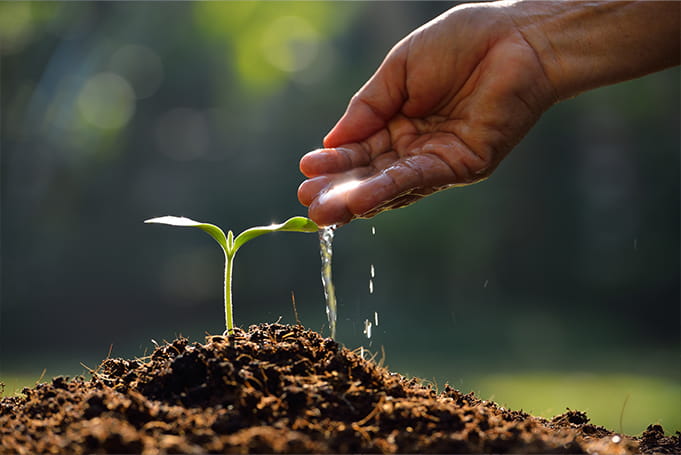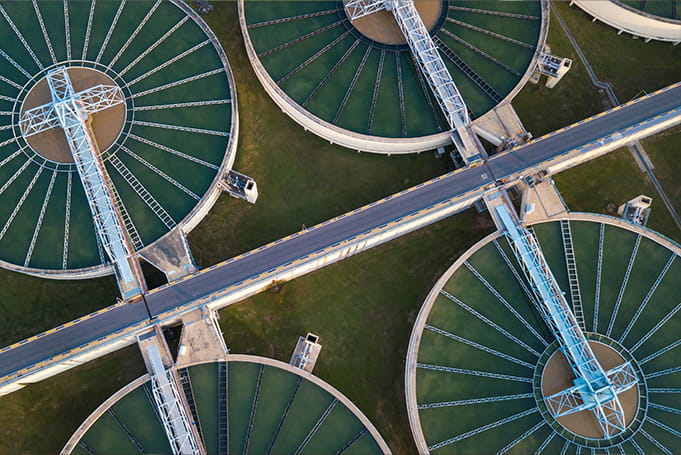Read the latest thoughts and analysis on breakthrough solutions driving impact for a sustainable future
The future of water: climate adaptation and mitigation

Covering most of the planet’s surface, water is seemingly one of the most abundant substances on earth. But today, many communities and countries are facing a usable water crisis.
While millions of people worldwide use hundreds of litres of water a day, around 3.6 billion people – almost half of humanity – survives without access to safe, clean water.
More than an inconvenience, access to clean water is essential for human health, growth, wellbeing and safety, so much so that it has been recognized as a human right. A lack of it can be devastating: 1 million people die each year from lack of access to clean water and sanitation, and every two minutes a child dies from a water-borne disease. Women and girls are particularly affected when clean water is in short supply, often tasked with hauling water over long distances for communities, taking them away from education and exposing them to violent attacks or environmental threats.
Without intervention, the next few decades could make this a reality for more and more people worldwide.
With increasing demand from water-intensive industries like agriculture, rising temperatures and shrinking water reserves, there is a real threat that there won’t be enough water for humanity’s needs. It’s a problem that has had experts ringing alarm bells since before 2017.
With access to water so critical, and the problem so pressing, why isn’t water management demanding more global attention? Is anything being done to bring it into wider conversations about sustainability? On today’s trajectory, what’s the future of water?

The future of water as it stands
Two opposing trends paint a grim picture of the future. While global water use is set to skyrocket, global water supplies are already stressed.
To keep up with demand, experts predict that global water use will rise 20-50% as a result of human-driven climate change and overuse. So much groundwater has been pumped out of the earth that it has tilted the planet’s axis.
Heavy use of water is compounded by mismanagement: without policies, infrastructure and conservation efforts, existing water sources are being polluted, wasted or drained. Worldwide, different challenges in managing water are causing water stress for communities: from outdated infrastructure to conflict to overuse, it’s clear that alongside preserving our existing sources of water, understanding how we use what we have as a global community is just as important.
On this trajectory, developing countries will experience water insecurity over longer periods and with greater intensity, while supplies to major industries become strained. Over the next two decades, the increasing water stress will lead to a rise in related inequality, political instability, growing disease and potential sources of conflict in the most affected nations.
How can we change this trajectory?
Top priorities for cleaner, healthier water
As the global community attempts to address the challenge of building a more sustainable future, the issue of water has garnered more attention. While the subject of water has been historically absent from international sustainability efforts like the Paris Agreement, both COP27 and COP28, held in Dubai in one of the world’s most arid regions, recognized water as a priority.
As governments, institutions and communities examine their relationship with water and their future needs, there is an overall consensus that the battle for water must be fought on all fronts. As a complex issue with multiple causes, it calls for many solutions across government, education, technology and industry, all working in tandem.
Individuals – from ordinary households to decision makers at the helm of major corporations – must gain a better understanding of the impact of water usage and consumption. Awareness campaigns like the USA’s Save Our Water can help change behavior and influence change at the individual level. At the national level, governments can leverage policy to support better understanding and use of water management.
Backed by funding, recent innovations in water management technology have the potential to help restore and manage water. Emerging AI and big data technologies, in particular, hold much promise. A pilot project in the Ramotswa Aquifer between South Africa and Botswana, for example, is harnessing AI to analyze water levels in the drought-prone area, helping identify patterns and inform water management decisions. AI-assisted geospatial analysis is also helping smallholders in Ethiopia to identify shallow well locations, something that promises to significantly improve crop yield and access to drinking water.
While new technologies have the potential to help solve significant challenges, prioritizing cost-effective and culturally compatible solutions remains key. Obstacles like supply chain coordination, training and distribution also need to be overcome for effective implementation. Introducing innovative financial instruments like water credits (akin to carbon credits) could incentivize investment in water-related initiatives and contribute to sustainable water management practices worldwide.

Climate Adaptation and Mitigation
The issue of water is inextricably tied to the wider climate emergency. Meeting the Paris goals by reducing carbon emissions, implementing overall climate mitigation measures and adapting to today’s changes are a key part of addressing the water crisis and building safeguards for the future.
Climate adaptation measures can be integrated into water systems and infrastructure and are essential for building resilience to climate change-induced water scarcity and extreme weather events. This involves implementing strategies such as rainwater harvesting, enhancing water storage capacity, and improving flood management systems to mitigate the impacts of climate change and ensure reliable access to water.
More broadly, general climate mitigation efforts are fundamental for addressing the underlying causes of the global water crisis. By mitigating climate change, we can help stabilize weather patterns, reduce the intensity of droughts and floods, and safeguard water resources for future generations.
Water is a critical resource, and its future is in our hands. To help people access water today and ensure water security for tomorrow, the global community must recognize, invest and mobilize to create better water management practices and safeguard the precious water we have remaining. The task is complex, but vital. We must come together to solve the problems we face for a greener, more sustainable future.


